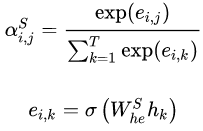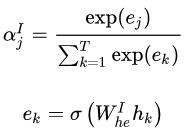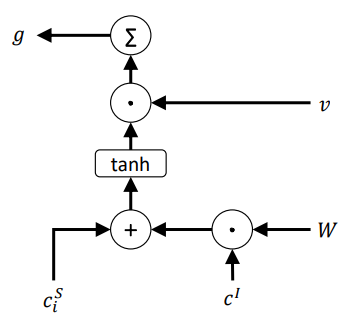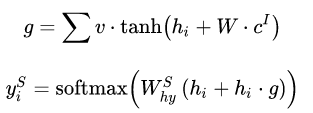
在《Attention-Based Recurrent Neural Network Models for Joint Intent Detection and Slot Filling》中的模型attention-based rNN model基础上,提出了slot-gate门。
通过slot-gate来加强intent与slot任务的交互性。见文章《Slot-Gated Modeling for Joint Slot Filling and Intent Prediction》。
模型步骤:
1.意图识别是利用encoder中的最后一个time step中的双向隐层,利用attention加权平均,最后接一个fc层进行分类
2.槽填充是序列标注,双向隐状态加attention权重,最后接一个fc层分类。
a.上图a中模型结构,利用了slot attention与intent attention。经过gate门后的值与每个时间步中的slot attention进行交互。
b.上图b中模型结构,只利用了intent attention。经过gate门后的值与每个时间步的隐状态进行交互。
3.总的loss = 意图识别loss + 槽填充loss
一.attention-based rnn 模型步骤:
1.底层是bilstm或bigru,输入为用户语句序列,输出为隐状态
2.槽填充为序列标注任务,将用户语句序列映射到槽标签中。
slot context vector:
槽注意力向量是隐状态加权和:
 (1)
(1)
槽注意力权重:
 (2)
(2)
最后将隐状态和槽上下文向量用于预测标签序列:
 (3)
(3)
这里的slot context vector就是对于每个位置,有一个对应的前馈网络权重,经过前馈网络和激活函数得到
,经过softmax得到
。再由(1)得到slot上下文向量。
3.意图识别为分类任务,用bilstm或bigru最后一个时间步隐状态进行预测。
intent context vector:
注意力向量的计算和槽注意力向量计算一致:
 (4)
(4)
注意力权重:
 (5)
(5)
最后一个隐状态和意图上下文向量用于预测意图类别:
 (6)
(6)
slot-gate机制
 (7)
(7)
带slot-attention和intent-attention的gate机制
slot-gate的计算:
 (8)
(8)
这里的可看做是一个加权特征,那么(3)式中的槽序列预测公式可改为:
 (9)
(9)
g越大,表示slot context vector和intent context vector关注的是输入序列的同一部分,也说明槽与意图之间的相关性更强,则context vector对预测结果的贡献更可靠。
只带intent-attention的gate机制,将(8)和(9)改为如下:
 (10)
(10)
二.模型代码:
完整程序见https://github.com/jiangnanboy/intent_detection_and_slot_filling/tree/master/model3
# build model device = torch.device('cuda' if torch.cuda.is_available() else 'cpu') # 构建slotgate计算方式,利用slot context与intent context class SlotGate(nn.Module): def __init__(self, hidden_dim): super(SlotGate, self).__init__() self.fc_intent_context = nn.Linear(hidden_dim, hidden_dim) self.fc_v = nn.Linear(hidden_dim, hidden_dim) def forward(self, slot_context, intent_context): ''' 注意这里slot_context是slot上下文context,[batch_size, hidden_dim],或者是时间步的hidden intent_context:[batch_size, hidden_dim] ''' # intent_context_linear:[batch_size, hidden_dim] intent_context_linear = self.fc_intent_context(intent_context) # sum_intent_slot_context:[batch_size, hidden_dim] sum_intent_slot_context = slot_context + intent_context_linear # fc_linear:[batch_size, hidden_dim] fc_linear = self.fc_v(torch.tanh(sum_intent_slot_context)) # sum_gate_vec:[batch_size] sum_gate_vec = torch.sum(fc_linear, dim=1) return sum_gate_vec # 这里计算slot context与intent context。就是bigru每个时间步隐藏特征的加权向量,这里不同于原论文的计算方式,这里使用点乘来计算注意力权重weight class AttnContext(nn.Module): def __init__(self, hidden_dim): super(AttnContext, self).__init__() def forward(self, hidden, source_output_hidden): # source_output_hidden:[batch_size, seq_len, hidden_size] # hidden:[batch_size, hidden_size] hidden = hidden.unsqueeze(1) # [batch_size, 1, hidden_size] attn_weight = torch.sum(hidden * source_output_hidden,dim=2) # [batch_size, seq_len] attn_weight = F.softmax(attn_weight, dim=1).unsqueeze(1) # [batch_size, 1, seq_len] # 类似于注意力向量 attn_vector = attn_weight.bmm(source_output_hidden) # [batch_size, 1, hidden_size] return attn_vector.squeeze(1) # [batch_size, hidden_size] #构建模型 class BirnnAttentionGate(nn.Module): def __init__(self, source_input_dim, source_emb_dim, hidden_dim, n_layers, dropout, pad_index, slot_output_size, intent_output_size, seq_len, predict_flag, slot_attention_flag): super(BirnnAttentionGate, self).__init__() self.pad_index = pad_index self.hidden_dim = hidden_dim//2 # 双向lstm self.n_layers = n_layers self.slot_output_size = slot_output_size # 是否预测模式 self.predict_flag = predict_flag # 原论文中有两种模型结构,一个带slot_attention,一个不带slot_attention self.slot_attention_flag = slot_attention_flag self.source_embedding = nn.Embedding(source_input_dim, source_emb_dim, padding_idx=pad_index) # 双向gru,隐层维度是hidden_dim self.source_gru = nn.GRU(source_emb_dim, self.hidden_dim, n_layers, dropout=dropout, bidirectional=True, batch_first=True) #使用双向 # slot context self.slot_context = AttnContext(hidden_dim) # intent context self.intent_context = AttnContext(hidden_dim) # slotgate类 self.slotGate = SlotGate(hidden_dim) # 意图intent预测 self.intent_output = nn.Linear(hidden_dim, intent_output_size) # 槽slot预测 self.slot_output = nn.Linear(hidden_dim, slot_output_size) def forward(self, source_input, source_len): ''' source_input:[batch_size, seq_len] source_len:[batch_size] ''' if self.predict_flag: assert len(source_input) == 1, '预测时一次输入一句话' seq_len = source_len[0] # 将输入的source进行编码 # source_embedded:[batch_size, seq_len, source_emb_dim] source_embedded = self.source_embedding(source_input) packed = torch.nn.utils.rnn.pack_padded_sequence(source_embedded, source_len, batch_first=True, enforce_sorted=True) #这里enfore_sotred=True要求数据根据词数排序 source_output, hidden = self.source_gru(packed) # source_output=[batch_size, seq_len, 2 * self.hidden_size],这里的2*self.hidden_size = hidden_dim # hidden=[n_layers * 2, batch_size, self.hidden_size] source_output, _ = torch.nn.utils.rnn.pad_packed_sequence(source_output, batch_first=True, padding_value=self.pad_index, total_length=len(source_input[0])) #这个会返回output以及压缩后的legnths batch_size = source_input.shape[0] seq_len = source_input.shape[1] # 保存slot的预测概率 slot_outputs = torch.zeros(batch_size, seq_len, self.slot_output_size).to(device) aligns = source_output.transpose(0,1) # 为了拿到每个时间步的输出特征,即每个时间步的隐藏向量 output_tokens =[] # 槽识别 for t in range(seq_len): ''' 此时刻时间步的输出隐向量 ''' aligned = aligns[t]# [batch_size, hidden_size] # 是否需要计算slot attention if self.slot_attention_flag: # [batch_size, hidden_size] slot_context = self.slot_context(aligned, source_output) # [batch_size, hidden_size],意图上下文向量,利用bigru最后一个时间步的隐状态 intent_context = self.intent_context(source_output[:,-1,:], source_output) # gate机制,[batch_size] slot_gate = self.slotGate(slot_context, intent_context) # slot_gate:[batch_size, 1] slot_gate = slot_gate.unsqueeze(1) # slot_context_gate:[batch_size, hidden_dim] slot_context_gate = slot_gate * slot_context # 否则,利用每个时间步的隐状态与intent context计算slot gate else: # [batch_size, hidden_size],意图上下文向量,利用bigru最后一个时间步的隐状态 intent_context = self.intent_context(source_output[:,-1,:], source_output) # gate机制,[batch_size] slot_gate = self.slotGate(source_output[:,t,:], intent_context) # slot_gate:[batch_size, 1] slot_gate = slot_gate.unsqueeze(1) # slot_context_gate:[batch_size, hidden_dim] slot_context_gate = slot_gate * source_output[:,t,:] # 预测槽slot, [batch_size, slot_output_size] slot_prediction = self.slot_output(slot_context_gate + source_output[:,t,:]) slot_outputs[:, t, :] = slot_prediction #意图识别 intent_outputs = self.intent_output(intent_context + source_output[:,-1,:]) return slot_outputs, intent_outputs # 训练阶段 else: # 将输入的source进行编码 # source_embedded:[batch_size, seq_len, source_emb_dim] source_embedded = self.source_embedding(source_input) packed = torch.nn.utils.rnn.pack_padded_sequence(source_embedded, source_len, batch_first=True, enforce_sorted=True) #这里enfore_sotred=True要求数据根据词数排序 source_output, hidden = self.source_gru(packed) # source_output=[batch_size, seq_len, 2 * self.hidden_size],这里的2*self.hidden_size = hidden_dim # hidden=[n_layers * 2, batch_size, self.hidden_size] source_output, _ = torch.nn.utils.rnn.pad_packed_sequence(source_output, batch_first=True, padding_value=self.pad_index, total_length=len(source_input[0])) #这个会返回output以及压缩后的legnths batch_size = source_input.shape[0] seq_len = source_input.shape[1] # 保存slot的预测概率 slot_outputs = torch.zeros(batch_size, seq_len, self.slot_output_size).to(device) aligns = source_output.transpose(0,1) # 为了拿到每个时间步的输出特征,即每个时间步的隐藏向量 # 槽识别 for t in range(seq_len): ''' 此时刻时间步的输出隐向量 ''' aligned = aligns[t]# [batch_size, hidden_size] # 是否需要计算slot attention if self.slot_attention_flag: # [batch_size, hidden_size] slot_context = self.slot_context(aligned, source_output) # [batch_size, hidden_size],意图上下文向量,利用bigru最后一个时间步的隐状态 intent_context = self.intent_context(source_output[:,-1,:], source_output) # gate机制,[batch_size] slot_gate = self.slotGate(slot_context, intent_context) # slot_gate:[batch_size, 1] slot_gate = slot_gate.unsqueeze(1) # slot_context_gate:[batch_size, hidden_dim] slot_context_gate = slot_gate * slot_context # 否则,利用每个时间步的隐状态与intent context计算slot gate else: # [batch_size, hidden_size],意图上下文向量,利用bigru最后一个时间步的隐状态 intent_context = self.intent_context(source_output[:,-1,:], source_output) # gate机制,[batch_size] slot_gate = self.slotGate(source_output[:,t,:], intent_context) # slot_gate:[batch_size, 1] slot_gate = slot_gate.unsqueeze(1) # slot_context_gate:[batch_size, hidden_dim] slot_context_gate = slot_gate * source_output[:,t,:] # 预测槽slot, [batch_size, slot_output_size] slot_prediction = self.slot_output(slot_context_gate + source_output[:,t,:]) slot_outputs[:, t, :] = slot_prediction #意图识别 intent_outputs = self.intent_output(intent_context + source_output[:,-1,:]) return slot_outputs, intent_outputs

